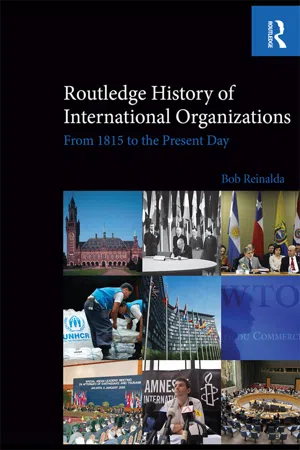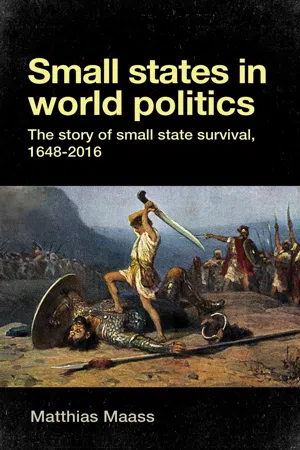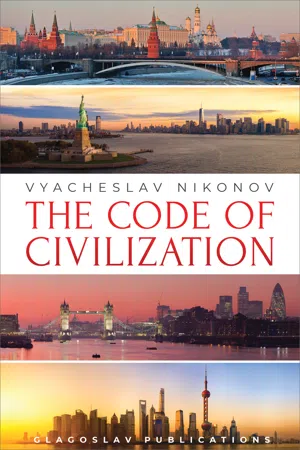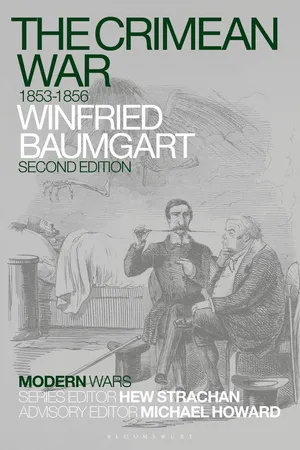Concert of Europe
The Concert of Europe refers to a system of international relations established in the early 19th century to maintain the balance of power and prevent major conflicts. It involved regular meetings between the major European powers to address diplomatic issues and maintain stability. The Concert of Europe aimed to prevent the resurgence of widespread conflict following the Napoleonic Wars.
7 Key excerpts on "Concert of Europe"
- eBook - ePub
- Stephen J. Lee(Author)
- 2008(Publication Date)
- Routledge(Publisher)
...5 The Concert of Europe 1815–48 The Concert of Europe is the term used to describe various attempts made by the major powers to co-operate, after 1815, in settling possible causes of conflict between themselves in order to prevent the possibility of another large-scale war. At first the European statesmen favoured a conciliar system; according to Article VI of the Quadruple Alliance (1815) ‘the High Contracting Powers have agreed to renew at fixed intervals…meetings consecrated to great common objects and the examination of such measures as at each one of these epochs shall be judged most salutary for the peace and prosperity of the nations and for the maintenance of the peace of Europe.’ 1 This provided the basis for the four further congresses which followed the Congress of Vienna itself, namely Aix-la-Chapelle (1818), Troppau (1820), Laibach (1821) and Verona (1822). By 1823, however, the attempt had broken down, and the idea of relating diplomacy to regular councils had to be abandoned. A major reason for this was that a gap opened between Britain and the continental autocracies of Austria, Russia and Prussia, caused largely by different policies over the question of intervention against revolutionary movements. Britain’s foreign secretaries, Castlereagh and Canning took their stand on a narrow and legalistic interpretation of the Quadruple Alliance, while the absolutist powers held to the Troppau Protocol of 1820 which was, in essence, a reinterpretation of the Holy Alliance of 1815. This conflict ended the possibility of a general conciliar system consisting of both constitutional and autocratic powers. It does not, however, explain why the autocratic powers failed to substitute a regular system of their own, either before or after 1823. The reason for this is twofold. On the one hand, the absolute monarchies had their own rivalries which prevented concerted action at several crucial stages...
- eBook - ePub
Routledge History of International Organizations
From 1815 to the Present Day
- Bob Reinalda(Author)
- 2009(Publication Date)
- Routledge(Publisher)
...The essential rules of behaviour alongside these norms were the use of conference diplomacy to deal with crises, the approval of territorial changes by the great powers, the protection of the essential members of the system and the absence of challenges to the interests and honour of the great powers. Among the common procedures were the mutual consultation and collective decision making, the creation of buffer states, the establishment of neutral states and demilitarized zones, the localization of regional conflicts, the limitation of resources in third areas, the delineation of interests and areas of involvement, the intervention by multilateral action, the peaceful settlement of disputes and the communication and provision of advance notification (Richardson 1999, 52). Four phases during the years 1815 – 56 Four distinct phases in the years between 1815 and 1856 characterize the Concert of Europe’s existence as a security regime: 1815–18 as a phase of technical cooperation with activities directed at the defeated France; 1818–22 as the proper congress system with conferences in Aix-la-Chapelle (1818, about France), Troppau (1820, about insurrections and Naples), Laibach (1821, about the Naples revolution) and Verona (1822, about Italy, Spain and the Eastern Question); 1822–48 as a period of subtle but significant management of the security relations of the great powers; 1848–56 as a period of regime decay between the revolutions of 1848 and the outbreak of the Crimean War (1854–56). During its second phase, the Concert of Europe adapted institutionally to the circumstances, ‘when it no longer needed ambassadors taking care of the administration of France’. The joint occupation of France ended after the conference in 1818 when France was admitted to the Concert. The Concert ‘changed its form to regular meetings at a higher level of representation in the form of congresses’...
- eBook - ePub
Small states in world politics
The story of small state survival, 1648-2016
- Matthias Maass(Author)
- 2017(Publication Date)
- Manchester University Press(Publisher)
...It existed as a de facto institution in the minds of diplomats and observers of the time. Statesmen openly referred to it in international treaties throughout the nineteenth century and did so with striking frequency. 32 A prominent example is the Treaty of Paris which ended the Crimean War in 1856, where reference is made to “Le Concert Européen.” 33 The treaty provides no further definition of the term, indicating the commonality of the concept even if it went by different names. 34 The nineteenth-century concert system integrated the previous era’s balance-of-power thinking into its operation. After all, for states to check and counter each other’s power was “a doctrine founded on the nature of man” according to the contemporary British prime minister Lord Palmerston. 35 As in the previous era, analogies to nature and natural law remained a very prominent “intellectual justification of the balance of power.” 36 Widely shared was the mechanical analogy of a pendulum. 37 A pendulum swings back and forth but must always come back to its proper state of equilibrium. When this picture was applied to international politics, it suggested natural dynamics working to forestall extreme changes and always pulling things back towards the center. A point of perfect equilibrium, of a natural state, existed. With respect to the realities of international politics, all treaty parties at Vienna shared the goal of at least a “partial equilibrium” among the major European powers. 38 System-wide order was to be achieved by consultation and diplomacy. Article VI of the Treaty of Paris, concluded between defeated France and the victorious anti-Napoleonic coalition in 1815, required the signatories to consult with each other regularly...
- eBook - ePub
The First Age of Industrial Globalization
An International History 1815-1918
- Maartje Abbenhuis, Gordon Morrell(Authors)
- 2019(Publication Date)
- Bloomsbury Academic(Publisher)
...Thus, the third and perhaps most important foundation of the Vienna treaty was that no one country could dominate the continent like Napoleonic France had done. The monarchs agreed that an equilibrium of power should exist between them and agreed on a series of principles to balance that power relatively equally. The diplomatic system that evolved in the wake of the Vienna treaty was invariably labelled the ‘Concert of Europe’ or the ‘congress system’. It aimed at compromise, negotiation and collective solutions rather than unilateral or bilateral decision-making. The congress system worked because the compromises developed by the European powers were effective ones. They depended on the willingness of the European governments (and particularly the great powers of Russia, Britain, Austria, Prussia and France) to negotiate solutions to international crises. The historian Hedley Bull described this willingness to compromise a ‘custodial duty’: a recognition that if the great powers collectively managed each and every diplomatic crisis, however small, then wars could be avoided, revolutions could be prevented and stability could be sustained. 10 Restoration largely depended on the avoidance of revolutions and wars: revolutions because the people could overthrow the monarchies, and wars because they created insecurities that might lead the people to revolt. The Congress of Vienna treaty then established key principles to avoid war between rival European nations. In the first place, it did so by setting up buffer states and independent cities. The Holy Roman Empire, for example, was not re-established. It was replaced by the Austrian Habsburg empire, the Kingdom of Prussia, and 37 other independent German territories, each with their own ruler (see Figure 2.1)...
- eBook - ePub
- Henry Kissinger(Author)
- 2011(Publication Date)
- Simon & Schuster(Publisher)
...CHAPTER FOUR The Concert of Europe: Great Britain, Austria, and Russia W hile Napoleon was enduring his first exile, at Elba, the victors of the Napoleonic Wars assembled at Vienna in September 1814 to plan the postwar world. The Congress of Vienna continued to meet all during Napoleon’s escape from Elba and his final defeat at Waterloo. In the meantime, the need to rebuild the international order had become even more urgent. Prince von Metternich served as Austria’s negotiator, though, with the Congress meeting in Vienna, the Austrian Emperor was never far from the scene. The King of Prussia sent Prince von Hardenberg, and the newly restored Louis XVIII of France relied on Talleyrand, who thereby maintained his record of having served every French ruler since before the revolution. Tsar Alexander I, refusing to yield the Russian pride of place to anyone, came to speak for himself. The English Foreign Secretary, Lord Castlereagh, negotiated on Great Britain’s behalf. These five men achieved what they had set out to do. After the Congress of Vienna, Europe experienced the longest period of peace it had ever known. No war at all took place among the Great Powers for forty years, and after the Crimean War of 1854, no general war for another sixty. The Vienna settlement corresponded to the Pitt Plan so literally that, when Castlereagh submitted it to Parliament, he attached a draft of the original British design to show how closely it had been followed. Paradoxically, this international order, which was created more explicitly in the name of the balance of power than any other before or since, relied the least on power to maintain itself. This unique state of affairs occurred partly because the equilibrium was designed so well that it could only be overthrown by an effort of a magnitude too difficult to mount. But the most important reason was that the Continental countries were knit together by a sense of shared values...
- eBook - ePub
- Vyacheslav Nikonov, Huw Davies(Authors)
- 2021(Publication Date)
- Glagoslav Publications B.V. (N)(Publisher)
...In the European Concert of Powers The Russian forces set off to “catch the monster in its lair”. Russia’s position at the time was strong enough to secure the signing of the second Paris agreement in November 1815, signed after Napoleon’s capitulation on behalf of a vanquished France by the Duke Armand-Emmanuel de Richelieu (better known in Russia as Emmanuil Osipovich) – a lieutenant-general in the Russian army and founder of the city of Odessa, who was at that time prime minister of France under King Louis XVIII. Alexander I was the man who initiated the creation of the Holy Alliance, intended to preserve the new political status quo in Europe; the deed creating this alliance was written with his hand. It was an alliance of Christian states, originally Russia, Austria and Prussia, which was subject to “the divine truths taught by the eternal law of God the Savior”. The Prince Regent of England, George, Prince of Wales, later joined the alliance (as the Hanover Regent), and so too did the French, Swedish and Norwegian kings, and the kings of Denmark, the Netherlands, Sardinia, the two Sicilies, Spain, Portugal, the states and free cities of Germany, and the Swiss union. Only Turkey remained outside the framework of the common European-wide system. This marked the start of the European concert of powers, which gave the Old World the most peaceful century in its history...
- eBook - ePub
The Crimean War
1853-1856
- Winfried Baumgart(Author)
- 2020(Publication Date)
- Bloomsbury Academic(Publisher)
...All the issues mentioned here are discussed at length in this book. There are two collections of essays commemorating the 150th anniversary of the peace congress: George-Henri Soutou (ed.), Napoléon et l’Europe. 1856, le congrès de Paris (Versailles, 2006); Gilbert Ameil (ed.), Le congrès de Paris (1856). Un événement fondateur (Brussels, 2009). How the results of the war related to the execution of the peace treaty is dealt with by Werner E. Mosse, The Rise and Fall of the Crimean System, 1855–71: The Story of a Peace Settlement (London, 1963). For a general discussion on the context of international relations, cf. the corresponding chapters in Winfried Baumgart, Europäisches Konzert und nationale Bewegung. Internationale Beziehungen 1830–1878 (Paderborn, 1999, 2nd edn 2007). A new study on Austria after the war is provided by Katharina Weigand, Österreich, die Westmächte und das europäische Staatensystem nach dem Krimkrieg (1856–1859) (Husum, 1997)....






